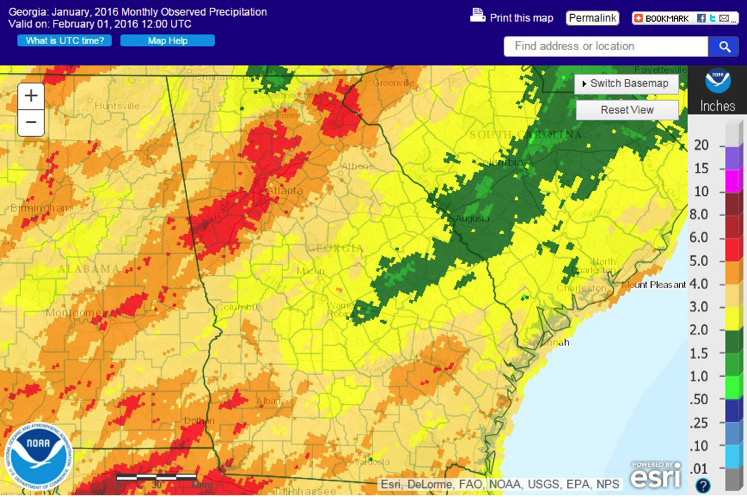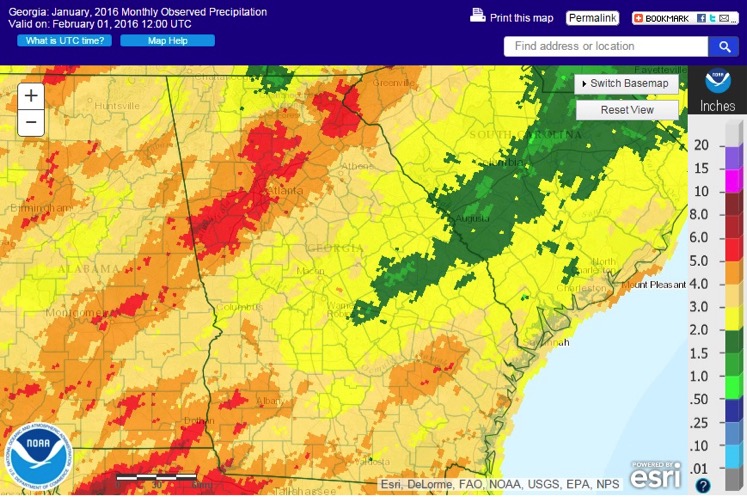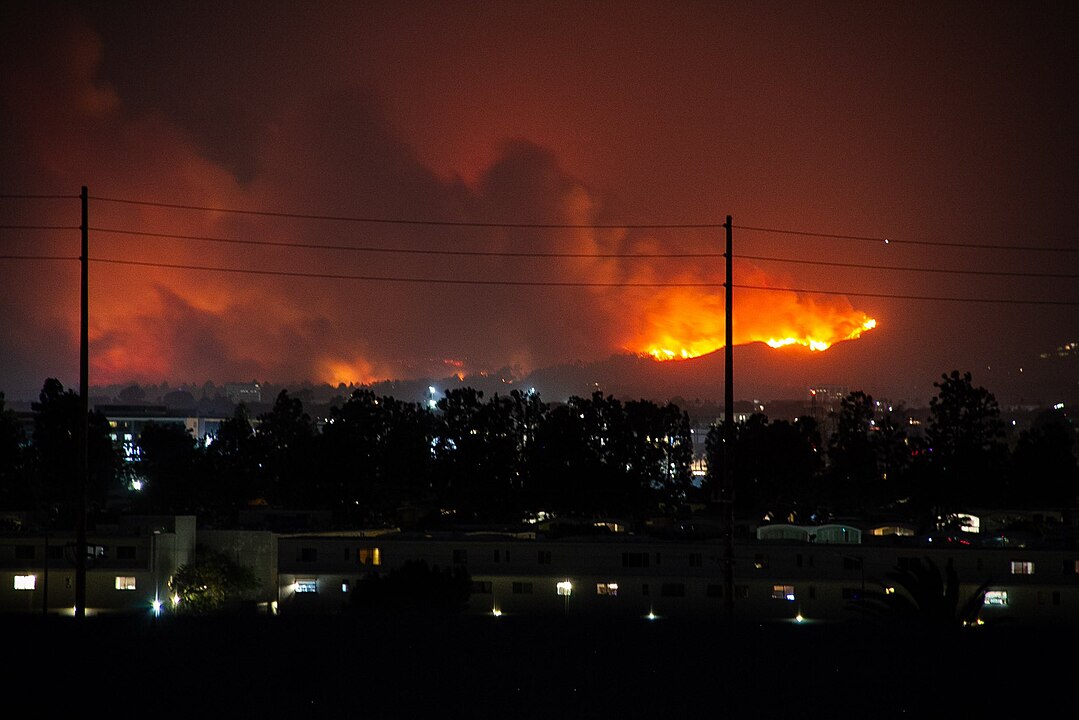After a record-setting warm December 2015, January 2016 in Georgia was slightly cooler and drier than normal. While El Niño conditions mean a continuation of slightly cooler-than-normal conditions in February, it should also mean a wetter-than-normal month.
Wet conditions through February have the potential to delay farmers and the start of planting season.
In January, despite the state being drier than normal, Alma, Georgia, and Atlanta, Georgia, saw higher-than-normal rainfall, with Alma recording 0.33 inches above normal, for a total of 4.59 inches, and Atlanta recording 0.94 inches above normal, for a total of 5.14 inches. Atlanta recorded the highest rainfall in the state during January.
Rain early in the month caused problems with flooding in some locations. A mail carrier’s vehicle was swept away by a flooding creek in Oglethorpe County, Georgia, after the carrier made a wrong turn and drove across a flooded roadway. Fortunately, the carrier was rescued after being trapped in the vehicle for a couple of hours.
According the National Weather Service, the lowest precipitation total recorded in the state during January was in Augusta, Georgia, with 1.66 inches, 2.25 inches below normal. Athens, Georgia, received 3.68 inches, 0.37 inches below normal; Columbus, Georgia, received 3.20 inches, 0.65 inches below normal; Macon, Georgia, received 2.52 inches, 1.72 inches below normal; Savannah, Georgia, received 3.13 inches, 0.56 inches below normal; Brunswick, Georgia, received 3.15 inches, 0.07 inches below normal; Rome, Georgia, received 3.37 inches, 1.45 inches below normal; Valdosta, Georgia, received 3.89 inches, 0.68 inches below normal; and Albany, Georgia, received 3.66 inches, 1.16 inches below normal.
The highest verified single-day rainfall from Community Collaborative Rain, Hail and Snow Network volunteers was 2.82 inches near Riverdale, Georgia, in Clayton County on Jan. 22, followed by 2.65 inches near Gainesville, Georgia, in Hall County on the same date. The highest monthly total rainfall was 6.85 inches, observed near Dillard, Georgia, in Rabun County, followed by 6.69 inches near Cairo, Georgia, in Grady County. The Dillard observer also reported the highest snowfall for the month, with a total of 8.5 inches reported.
Temperatures across the state were below normal in January. In Atlanta, the monthly average temperature was 42.4 degrees Fahrenheit, 0.9 degrees below normal; Athens averaged 42 F, 1.5 degrees below normal; Columbus averaged 45.5 F, 1.7 degrees below normal; Macon averaged 44.9 F, 1.4 degrees below normal; Savannah averaged 48.4 F, 1.1 degrees below normal; Brunswick averaged 50.6 F, 0.9 degrees below normal; Augusta averaged 44.2 F, 1.2 degrees below normal; Albany averaged 48.1 F, 1.2 degrees below normal; Alma averaged 48.6 F, 2.1 degrees below normal; Rome averaged 39.5 F, 1.6 degrees below normal; and Valdosta averaged 50.1 F, 0.3 degrees below normal. However, combined with the record-setting warm December temperatures, the winter so far is still well above normal as far as temperature.
Two record low daytime high temperatures were set in January. Savannah and Alma both set records on Jan. 23. Savannah reported a daytime high of 40 F, beating the old record of 41 F, and Alma reported a daytime high of 41 F, beating the old record of 42 F. Both of the old records were set in 2003.
No severe weather was reported in January in Georgia, although some unofficial reports of high winds were received during the month.
The outlook for February and early spring shows the continuation of El Niño-like weather. After the El Niño dies away, a swing to La Niña is expected by late summer, which will increase the chance of dry conditions later in the growing season. The Atlantic tropical season is also expected to be more active than usual in the absence of an El Niño.
For more information, please see the Climate and Agriculture in the South East (CASE) blog at blog.extension.uga.edu/climate, or visit gaclimate.org. Please feel free to email your weather and climate impacts on agriculture to pknox@uga.edu to share on the blog.








